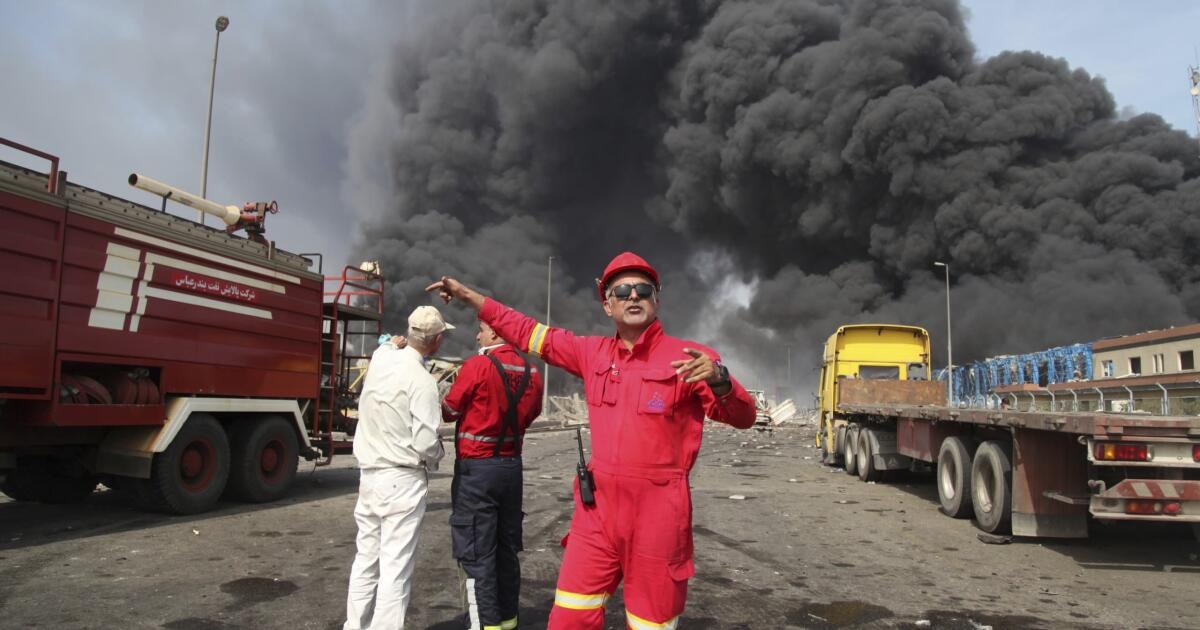MUSCAT, Oman — A massive explosion and fire rocked a port Saturday in southern Iran purportedly linked to a shipment of a chemical ingredient used to make missile propellant, killing five people and injuring more than 700 others.
Mehrdad Hasanzadeh, a provincial disaster management official, gave the updated casualty figure in an interview on state television. The previous toll was four dead and more than 500 others injured.
The blast at the Shahid Rajaei port happened as diplomats from Iran and the United States met Saturday in Oman for the third round of negotiations over Tehran’s rapidly advancing nuclear program.
No one in Iran suggested that the explosion was the result of an attack. On Wednesday, however, Iranian Foreign Minister Abbas Araghchi, who led Iran in Saturday’s talks, acknowledged that “our security services are on high alert given past instances of attempted sabotage and assassination operations designed to provoke a legitimate response.”
For hours, authorities in Iran offered no clear explanation for what caused the blast at the port, just outside Bandar Abbas, though they denied that the explosion had anything to do with the country’s oil industry.
The port took in a shipment of “sodium perchlorate rocket fuel” in March, the private security firm Ambrey said. The fuel is part of a shipment from China by two vessels to Iran first reported in January by the Financial Times. The fuel was going to be used to replenish Iran’s missile stocks, which had been depleted by its direct attacks on Israel during that country’s war with Hamas in the Gaza Strip.
“The fire was reportedly the result of improper handling of a shipment of solid fuel intended for use in Iranian ballistic missiles,” Ambrey said.
Ship-tracking data analyzed by the Associated Press put one of the vessels believed to be carrying the chemical in the vicinity in March, as Ambrey said. Iran hasn’t acknowledged taking the shipment. The Iranian mission to the United Nations didn’t immediately respond to a request for comment Saturday.
It’s unclear why Iran wouldn’t have moved the chemicals from the port, particularly after the Beirut port blast in 2020. That explosion, caused by the ignition of hundreds of tons of highly explosive ammonium nitrate, killed more than 200 people and injured more than 6,000 others. Israel, however, did target Iranian missile sites where Tehran uses industrial mixers to create solid fuel.
Social media video of the explosion on Saturday at Shahid Rajaei showed reddish-hued smoke rising from the fire just before the detonation. That suggests a chemical compound involved in the blast.
“Get back! get back! Tell the gas [truck] to go!” a man in one video shouted just before the blast. “Tell him to go, it’s going to blow up! Oh, God, this is blowing up! Everybody evacuate! Get back! Get back!”
On Saturday night, the state-run Islamic Republic News Agency said that Iran’s Customs Administration blamed the blast on a “stockpile of hazardous goods and chemical materials stored in the port area,” without elaborating.
Shahid Rajaei has been a target in the past. A 2020 cyberattack attributed to Israel targeted the port, after Israel said that it had thwarted a cyberattack targeting its water infrastructure, which it attributed to Iran.
Social media videos after the explosion showed black billowing smoke. Others showed glass blown out of buildings miles from the blast site. State media video showed the injured crowding into at least one hospital, with ambulances arriving as medics rushed one person past on a stretcher.
Hasanzadeh, the provincial disaster management official, earlier told state television that the blast originated from containers at Shahid Rajaei, without elaborating. State television also reported that the explosion has caused a building to collapse, though no details were offered.
The Interior Ministry said it had launched an investigation into the blast. Iranian President Masoud Pezeshkian offered his condolences for those affected.
The Shahid Rajaei port in Hormozgan province is about 650 miles southeast of Tehran on the Strait of Hormuz, the narrow mouth of the Persian Gulf through which 20% of all oil traded passes.
Gambrell writes for the Associated Press.
